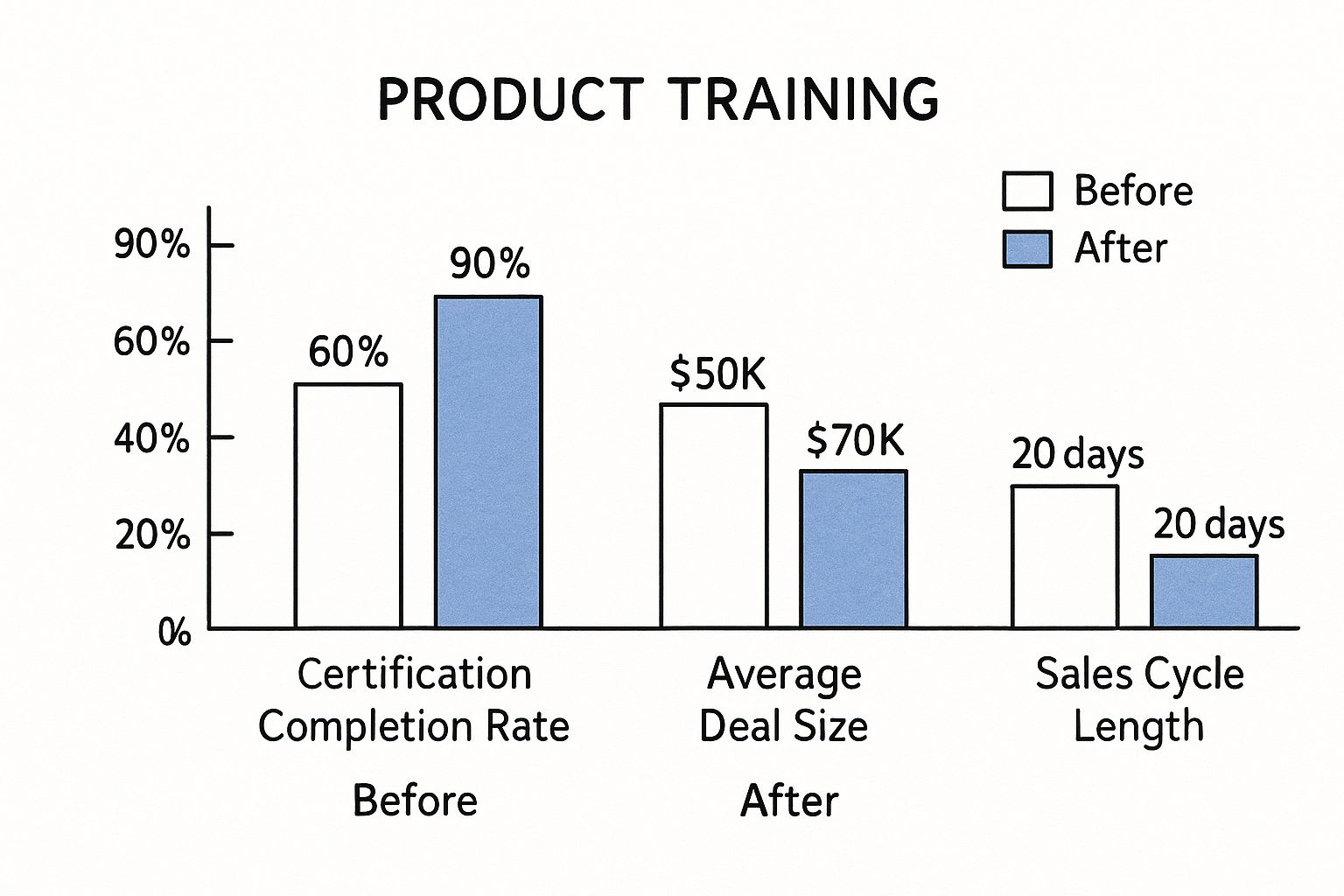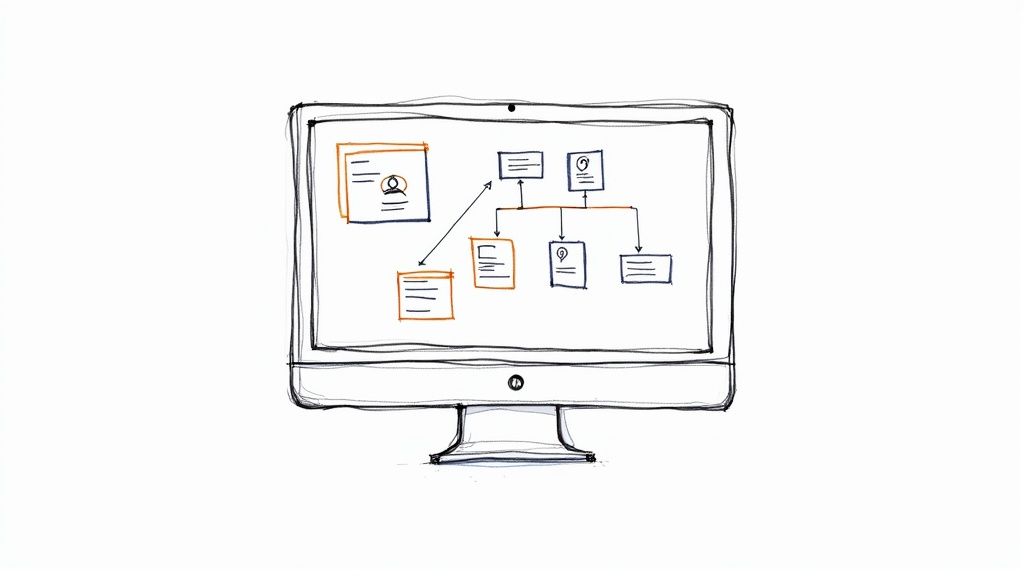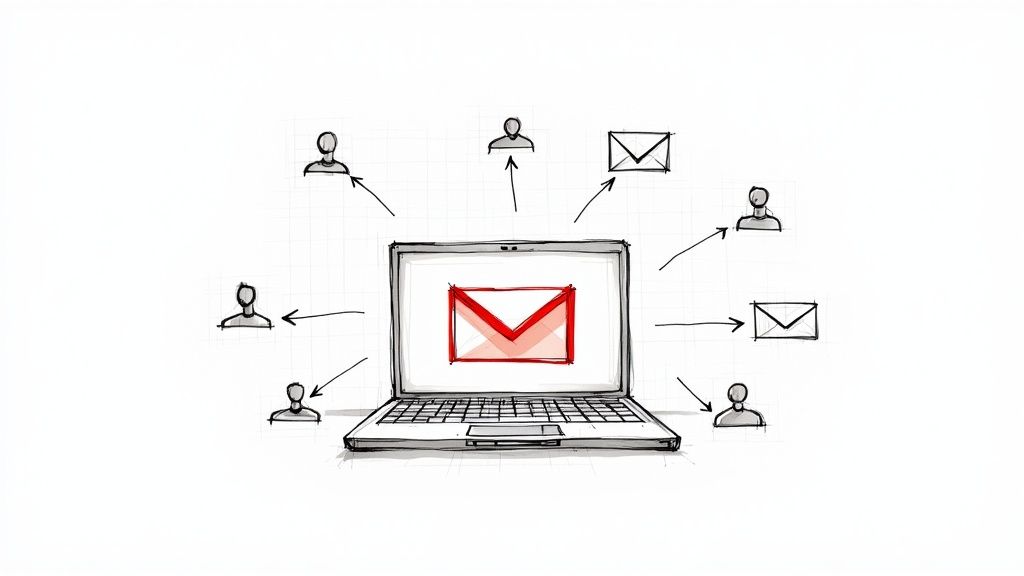Boosting your sales performance isn't just about pushing harder or using aggressive tactics.Improving sales performance is about more than just aggressive tactics; it boils down to building a solid foundation of clear goals, optimizing your sales process, and equipping your team with the right skills. Lasting success comes from a strategic, data-driven approach, not simply chasing higher numbers without a plan.
Setting the Foundation for Sales Success

Before you can even think about boosting outcomes, you need to define what "high performance" actually means for your team. It’s a classic mistake to fixate on the final revenue number while completely ignoring the building blocks that get you there. A solid framework built on clear, intentional goals is the only real first step toward sustainable growth.
This means ditching vague objectives and adopting a system that actually works. When you establish goals that have real meaning, you build a culture of accountability and hand your team a clear map to follow.
Establish SMART Goals
The SMART framework has been around forever for a reason: it works. It’s a proven method for creating goals that are well-defined and actionable, stripping away all the ambiguity from the process.
- Specific: Instead of "increase sales," get granular. A truly specific goal sounds like, "Increase enterprise client acquisition by 15%." Everyone knows exactly what the target is.
- Measurable: Every goal needs a number attached. "Grow our monthly recurring revenue (MRR) by $20,000" is measurable. "Grow our revenue" is just a wish.
- Achievable: Your goals should stretch the team, not break them. Look at your historical data and market conditions to set targets that are challenging but realistic. This keeps morale high and prevents burnout.
- Relevant: Each sales goal must ladder up to the big-picture company objectives. If the company is pushing for market penetration, a relevant goal would be to land a certain number of new logos in a key territory.
- Time-bound: Deadlines create a healthy sense of urgency. A goal like, "Increase the average deal size by 10% within the next quarter" sets a clear finish line.
A well-defined goal acts as a compass for your sales team. When reps know exactly what they're aiming for and why it matters, their daily activities become more focused and effective, directly impacting your ability to improve sales performance.
Identify KPIs That Truly Matter
Once your goals are locked in, you need to track the right metrics to see how you're doing. Too many teams fall into the trap of tracking "vanity metrics"—like the raw number of calls made—which show activity but tell you nothing about effectiveness. Real performance improvement comes from obsessing over the key performance indicators (KPIs) that signal genuine progress.
For instance, a high call volume means nothing if your conversion rate is in the gutter. You need to focus on metrics that give you real insight into the health of your sales pipeline and the efficiency of your process. You can learn more about structuring this by checking out our guide on how to create a sales plan.
Here are a few critical KPIs you should be tracking:
- Win Rate: This is the percentage of closed-won deals versus your total opportunities. If this number starts to dip, it could signal problems with your value prop or sales process.
- Sales Cycle Length: What's the average time it takes to close a deal? A shortening sales cycle is a great sign of improved efficiency and a more compelling offer.
- Average Deal Size: This simple metric tells you if you're successfully upselling or moving into higher-value accounts.
- Lead-to-Opportunity Conversion Rate: This shows you the quality of your leads and how effective your initial qualification is. A healthy benchmark for this conversion is around 30%.
By focusing on these foundational elements—crystal-clear goals and meaningful KPIs—you start to build a data-driven culture. This setup doesn't just help improve sales performance today; it builds a resilient, adaptable team ready for long-term success.
Optimizing Your Sales Process With Technology
Let's be honest, your sales team's most valuable asset is time. But how much of their week is spent on tasks that don't actually move the needle? Too often, reps get bogged down in administrative work that has nothing to do with generating revenue.
This is where technology, specifically a well-implemented Customer Relationship Management (CRM) system, becomes a game-changer. It’s the key to reclaiming that lost time and truly unlocking your team's sales potential.
A modern, cloud-based CRM is so much more than a digital Rolodex. Think of it as the single source of truth for your entire company. It breaks down the frustrating data silos that create friction between your sales, marketing, and customer success teams. When everyone is on the same page, the customer experience is seamless, and internal processes get a whole lot smoother.
From Manual Data Entry to Automated Workflows
The first place to look for quick wins is automating the low-value, repetitive tasks that drain your team's energy. Think about all those hours spent on manual data entry, setting follow-up reminders, or pulling together weekly reports. These activities might be necessary, but they come at a huge opportunity cost.
A good CRM can automate most of this grunt work. For instance, you can easily set up workflows to:
- Automatically log calls, emails, and meetings under the right contact. No more "I'll do it later."
- Trigger follow-up tasks based on a prospect’s actions, like if they visit your pricing page.
- Generate and send out performance dashboards to leadership every Monday morning like clockwork.
This isn't just about saving time. It's about improving data accuracy and ensuring critical follow-ups never fall through the cracks. To really boost sales performance, you have to nail your internal processes first. Diving into sales process optimization strategies for success is a great next step.
Just look at the direct impact that proper tool use and training can have on your team's core metrics.

The numbers don't lie. Investing in your team's proficiency with their tools leads directly to bigger deals that close faster. It's a clear path to better sales performance.
Unleashing the Power of AI and Predictive Analytics
Beyond basic automation, modern CRMs are now supercharged with artificial intelligence (AI), giving you a serious competitive edge. These features help your team shift from being reactive to proactive, focusing their energy where it will make the biggest difference.
The CRM market's explosive growth—projected to hit $80 billion by 2025—is being driven by these advanced capabilities. This makes sense when you consider that a whopping 94% of businesses report a jump in sales productivity after adopting a CRM. These aren't just vanity metrics; users see tangible results like sales increases of up to 29% and a 42% improvement in forecast accuracy. And it's all happening in the cloud, with 87% of businesses now using cloud platforms to get a complete picture of their customer data.
AI-powered tools can sift through massive amounts of historical data to give you predictive insights. Here are a few ways it can work for you:
- Predictive Lead Scoring: AI algorithms can analyze thousands of data points to pinpoint which leads are most likely to convert, so your reps can prioritize their outreach effectively.
- Customer Segmentation: AI can automatically group prospects based on subtle behavioral patterns, paving the way for highly targeted and personalized campaigns.
- Next-Best-Action Recommendations: Some platforms can even suggest the most effective next step for a specific deal, whether that's sending a case study or scheduling a demo.
The impact of CRM adoption is clear and consistently positive across the board. The data shows significant improvements in key areas that directly affect revenue and efficiency.
Impact of CRM Adoption on Sales Metrics
These figures highlight why a CRM is no longer a "nice-to-have" but an essential part of any serious sales operation. The right system pays for itself by driving growth and making the entire team more effective.
By integrating technology and AI into your sales process, you're not just making your team more efficient—you're making them smarter. You're giving them the data-driven insights they need to build stronger relationships and close more deals.
Ultimately, the goal is to choose and implement technology that directly helps your team sell better. For more practical ways technology can improve your results, check out our guide on foundational sales improvement strategies. Adopting the right tech stack turns your sales process from a series of manual chores into a well-oiled machine built for growth.
Give Your Team More Time to Actually Sell

What's the biggest killer of sales performance? It’s rarely a lack of skill or effort. It’s a lack of time.
Your sales reps are almost certainly drowning in tasks that have nothing to do with selling. Internal meetings, admin reports, hunting down the right case study—these "time thieves" slowly chip away at productivity until there's barely any day left for what actually matters.
The gap between activity and results is probably wider than you think. Sales reps globally spend a staggering 65% of their time on tasks that don't generate revenue. That leaves a measly 35% for actual selling. High-performing teams are obsessed with fixing this, using smart processes and automation to hand that time back to their sellers.
Reclaiming those lost hours is where you'll find your biggest performance gains. It all starts with figuring out where the time is really going.
Conduct a Ruthless Time Audit
You can't fix a problem you don't understand. The first move is to run a "time audit" to get a data-backed snapshot of your team's day-to-day reality. This isn't about micromanaging people; it's about spotting the broken systems that are holding everyone back.
For one week, have your reps track their time in a few key buckets. You’ll be surprised at what the data reveals.
- Selling Activities: Demos, discovery calls, negotiations, closing deals.
- Administrative Tasks: CRM updates, logging calls, internal reporting.
- Prospecting: Researching leads, digging for contact info.
- Content & Prep: Finding collateral, building decks, preparing for calls.
- Internal Meetings: Team syncs, all-hands, training sessions.
Once you see the numbers, the biggest time-sinks will jump right out at you. Now you can get to work.
A sales leader's most important job is to be a "distraction shield." Protect your team's focus by simplifying processes, running efficient meetings, and giving them tools that cut down on administrative busywork.
Implement Practical Solutions for Efficiency
With the audit done, you know where the leaks are. Now it's time to plug them with some practical, high-impact changes that give your team more time to do what they do best: sell.
Centralize Your Sales ContentHow many hours do reps lose digging through Slack channels or shared drives for the latest pricing sheet? This is an easy fix. A sales enablement platform or even just a meticulously organized cloud folder can solve this chaos overnight.
When all your marketing and sales materials are in one central hub, reps can find exactly what they need in seconds.
Standardize Common CommunicationsReps write the same handful of emails again and again. Build a library of pre-approved templates for common touchpoints like initial outreach, follow-ups, or post-demo thank-yous.
These templates give reps a solid, proven foundation they can quickly personalize. It’s the perfect blend of efficiency and that critical human touch. For teams wanting to take it up a notch, you can automate prospecting to handle that initial outreach at scale without sacrificing personalization.
Structure the Day for Deep WorkConstant context-switching is a productivity nightmare. Encourage your team to use time-blocking to carve out dedicated, uninterrupted windows for high-value work.
- Morning Block (9-11 AM): All-in on prospecting and outreach.
- Mid-Day Block (1-3 PM): Prime time for demos and client calls.
- End-of-Day Block (4-5 PM): Wrap up admin and prep for tomorrow.
This simple structure helps reps get into a flow state and stay there. By building a culture that values and protects focused time, you empower your team to reclaim their most valuable asset and drive serious results.
Build a Culture of Adaptability and Learning

Here's a hard truth: improving sales performance isn't a project you can just check off a list. It’s a complete cultural shift. The days of winning deals with rigid scripts and dusty playbooks are long gone. Today's top-performing sales teams are built on something else entirely—agility and a genuine hunger to learn.
The market is in constant motion. Customer needs evolve, and competitors can pivot on a dime. In this environment, adaptability isn't just a soft skill; it's your sharpest competitive edge. It’s what separates the teams that merely survive from those that truly thrive on change.
To get there, you have to empower your reps to think like scientists, constantly experimenting and learning from the results.
Foster Agility and Experimentation
An agile sales culture gives reps the psychological safety they need to try new things. It means you’re actively encouraging them to A/B test email subject lines, experiment with a different outreach channel, or take a fresh approach to a product demo.
When a new strategy falls flat? It's not a failure. It's a data point.
This mindset is everything. Instead of coming down on reps for experiments that don't pan out, you celebrate what was learned. This approach unlocks the creativity and responsiveness your team needs to handle today's increasingly complex buying journeys.
The key takeaway is simple: Empower your team to test, learn, and iterate without fear. An agile team that can pivot based on real-time feedback will always outperform a rigid one that’s stuck following an outdated script.
Commit to Continuous Development
Too many sales organizations treat training like a one-and-done onboarding event. This is a massive mistake. High-performing teams see skill development as an ongoing discipline. The tactics that helped a rep crush their quota last year might be totally ineffective next year.
This means investing in development that goes way beyond basic product knowledge. Modern sales training needs to be sophisticated and cover a wide range of skills.
- Advanced Negotiation: Get your reps past talking about price and focused on negotiating based on real value.
- Social Selling: Teach your team to build a personal brand and engage prospects authentically on platforms like LinkedIn.
- Objection Handling: Give your team the frameworks to navigate tough questions and turn pushback into a productive conversation. This is a skill that needs constant practice, and our guide on handling objections in sales offers some great techniques.
- Mastering New Tech: Make sure everyone is fluent in the entire sales stack, from your CRM to the latest AI-powered outreach tools.
Continuous coaching is what makes all of this stick. Regular one-on-ones, call reviews, and deal strategy sessions provide the personalized feedback reps need to actually improve. In fact, research shows that businesses that prioritize consistent coaching see 32% higher win rates.
When you create a supportive environment where learning is just part of the daily routine, you're doing more than just bumping up sales numbers. You're building a resilient, adaptable, and motivated team that can handle whatever comes their way. This cultural shift is the single most powerful investment you can make in your long-term success.
Let's be honest, the days of blasting generic, templated emails to hundreds of prospects are long gone. That old "spray-and-pray" tactic is exactly why cold outreach gets such a bad rap—it’s impersonal, lazy, and almost always gets ignored. If you want to actually move the needle on sales performance today, you have to stop thinking about volume and start focusing on value.
This is where AI stops being a buzzword and becomes a real, revenue-generating part of your toolkit. What was once impossible is now within reach: delivering hyper-personalized, one-on-one communication at scale. It’s all about making every single prospect feel like you’re talking directly to them, and only them.
Moving Beyond Generic Templates
The biggest problem with old-school outreach is its complete lack of relevance. A message that could be for anyone ends up being for no one. This is the exact problem modern AI platforms, like our own PlusVibe, were built to solve.
These tools dig through a prospect's public data—we're talking LinkedIn profiles, company announcements, recent articles, and online activity. The AI then pulls out the most interesting bits to craft opening lines and message hooks that are genuinely relevant to that specific person.
Think about your sales rep reaching out to a marketing director. Instead of the tired, "I saw you're in marketing," the AI might generate an opener like this:
"I was really impressed with your team's recent product launch campaign for the new X-series. The focus on user-generated content was a brilliant move. It got me thinking about how you're sustaining that momentum..."
Right away, this message proves the rep did their homework, understands the prospect’s world, and has a real reason for reaching out. It cuts through the noise and earns a reply.
Augmenting Your Team, Not Replacing It
A lot of people worry that AI will make sales reps obsolete. The reality is the complete opposite. AI's true strength is its ability to augment human skills, freeing up your team to do what they do best: build relationships and close deals.
Think of AI as a super-efficient research assistant for every single person on your sales team. It does the grunt work of digging up personal details and finding conversation starters. Your reps then take that foundation and build a genuine, human-to-human connection on top of it.
The dashboard above shows how a platform like PlusVibe simplifies this whole process, giving you clear metrics and total control over your campaigns. By automating that initial personalization, you're giving your team a massive head start on building rapport.
This frees up more of their time for strategic thinking and follow-up, which directly boosts sales performance. For a deeper dive into more advanced techniques, it's worth learning how you can supercharge your B2B lead generation with AI.
A Practical Workflow for AI-Powered Outreach
You don't need to rip out your entire sales process to get started. Integrating this kind of tech is about enhancing what you already do with a powerful new capability. Here’s a typical workflow:
- Define Your Ideal Customer Profile (ICP): The AI is only as smart as the instructions you give it. Start by getting crystal clear on the traits of your best customers—their industry, job title, company size, and the problems they're always trying to solve.
- Build Your Prospect List: Use your favorite methods to pull together a list of prospects that match your ICP. This might come from your CRM, a lead gen tool, or just good old-fashioned research on LinkedIn.
- Let the AI Do the Heavy Lifting: Upload that list to your AI outreach platform. The system will get to work, scanning every profile to find unique angles and relevant hooks for personalization.
- Review and Refine: The AI gives you the personalized drafts, but the human touch is what makes it shine. Reps need to review the AI's suggestions, tweak them to match their own voice, and add their own insights. This step is what keeps it authentic.
- Launch and Engage: Send the hyper-personalized messages and get ready for the reply rates to climb. Because your outreach is so relevant, you’re not starting a cold conversation anymore; you’re joining one that’s already happening in your prospect’s head.
This approach flips prospecting from a pure numbers game into a real relationship-building exercise. To go even deeper on this, our complete guide on using AI for sales prospecting has more strategies you can put to work immediately.
By embracing AI for personalization, you’re not just getting a new piece of software. You're fundamentally changing how you connect with people. You're giving your team the power to build more authentic connections, have better conversations, and ultimately, drive the kind of sales performance that leaves the competition behind.
Got Questions? We’ve Got Answers.
When you're overhauling your sales strategy, a few questions are bound to pop up. Let's tackle some of the most common ones I hear from sales leaders trying to make these changes stick.
How Quickly Can I Actually See Results?
Ah, the million-dollar question. The honest answer? It depends.
You can definitely get some quick wins in a matter of weeks. For instance, using an AI tool like PlusVibe to personalize your first hundred outreach emails could boost your reply rates almost overnight. That’s an immediate, positive signal.
But the real, game-changing shifts—like overhauling a clunky sales process or building a culture of continuous coaching—are more of a marathon. Think of these as long-term investments in sustainable growth. You should expect to see a real lift in your big-picture KPIs, like win rate and average deal size, over a quarter or two as the new habits and tools become second nature to your team.
The Bottom Line: You'll see encouraging signs in weeks, but the significant, lasting improvements will show up after a few months of consistent, focused effort.
Skills or Tech: Where Should I Put My Money?
This isn't an either/or dilemma. It's a "both/and" situation, and the best sales teams master the synergy between skilled reps and smart technology.
Think about it: you can give your team the most sophisticated CRM on the planet, but if they can't handle basic objections or build rapport, they're still not going to close. The tech is useless without the skill.
On the flip side, even your most talented, charismatic salesperson will hit a ceiling if they're bogged down by manual tasks and flying blind without data. Technology is the force multiplier. It automates the grunt work and serves up the insights that let your reps focus on what they do best: building relationships and closing deals.
What's the Single Biggest Mistake to Avoid?
In a word? Inconsistency. It's the silent killer of so many great sales initiatives.
I've seen it time and again: a sales leader gets fired up about a new strategy, pushes it hard for a month, and then… crickets. The next shiny object comes along, and the old initiative fades into the background.
Real improvement comes from sustained commitment. Whether it's daily coaching huddles, regular process reviews, or making sure everyone uses the tech stack properly, follow-through is everything. One-off training days don't work. Success comes from weaving these best practices into the very fabric of your team's daily rhythm until they become non-negotiable.
How Do I Motivate a Sales Rep Who’s Struggling?
This is a tough one, but the first step is always to diagnose before you prescribe. Don't jump to conclusions. Sit down with the rep for a real, honest conversation to get to the root of the problem.
It usually boils down to one of a few things:
- A Skill Gap? Maybe they need a refresher on product knowledge or some targeted coaching on handling a specific objection. This is often the easiest fix.
- A Process Problem? Is a clunky internal system or a lack of qualified leads holding them back? Sometimes the problem isn't the person; it's the system they're working in.
- A Personal Issue? Is something going on outside of work that's affecting their focus? A little empathy and support from a manager can make a world of difference here.
Once you know what you're dealing with, you can build a collaborative performance improvement plan. Set small, achievable goals to build momentum. This turns a punitive situation into a partnership and gives the rep a clear, manageable path back to hitting their numbers.
Ready to see how AI can transform your outreach and help you build campaigns that actually get replies? Learn more about PlusVibe and get started today.














































.jpeg)


.png)

















































